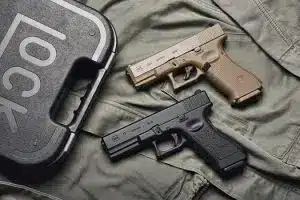Since 1982, the firearms Glock produces have earned a solid reputation among avid users for impressive reliability and performance. While Glocks come highly recommended because of the quality that goes into the manufacturing process, it’s important to be mindful of how you use this type of handgun so you don’t unintentionally affect how it works. The firearms safety education professionals from Online Texas LTC, your top choice if you want to take a Texas CHL class, discuss the topic of dry firing and what to keep in mind when it comes to a Glock.
What Is Dry Firing?
When you dry fire a Glock, or any firearm for that matter, what you’re doing is pulling the trigger when there’s not a live round in the chamber. In other words, you’re going through the motions of firing your gun without a bullet actually being discharged.
What Happens during a Dry Fire
When a Glock is dry fired, the hammer drops against the firing pin. You’ll still hear a click, but there’s nothing inside the chamber. Therefore, you won’t hear a popping sound because there’s no gunpowder ignited by the action of firing with no ammo in the gun. While this may seem like it does no significant harm to the firearm, there are some pros and cons associated with dry firing.
Dry Firing Benefits
Dry firing does serve a purpose. In fact, many professional shooters recommend dry firing as a way to work on technique without spending too much money on ammunition. This is even more of an issue today, since ammo is generally more expensive these days. By dry firing, you can become a more confident and effective gun owner and user while not going through a bunch of ammo in the process.
Potential Issues with Dry Firing
The argument against dry firing any firearm comes from a concern that the repeated action of firing without ammo in the gun could damage the firing pin and striker—or at least contribute to excess wear and tear. This can be what happens with older guns. Dry firing is also best avoided with traditional rifles and rim-fire weapons.
What the Manufacturer Has to Say
According to Glock, it’s okay to dry fire the handguns the company manufactures. Glock doesn’t specifically recommend regular dry firing, but the company doesn’t discourage it either. Dry firing, as stated earlier, does have its benefits. Many people, including professional shooters, have found that dry firing at home improves shooting and gun handling abilities.
Precautions to Take if You Dry Fire
As is the case with any firearm, it’s a good idea to take some precautions if you’re going to dry fire. With a Glock, if you dry fire fairly regularly for practice and cleaning purposes, consider using either dummy rounds or a snap cap. This protects the firing pin and striker from damage and excess wear. Dummy rounds also allow you to practice reloading because the slide of the handgun will release forward when a dummy round is in the magazine.
If you own a firearm, it’s essential to get high-quality training so you know how to handle, store, and shoot your gun safely. Online Texas LTC is dedicated to providing the finest firearms training available. Whether you simply need to learn how to handle a gun and shoot safely or you want to take a license to carry Texas class, reach out to the experienced pros at Online Texas LTC. Give us a call today at 512-675-2206.





